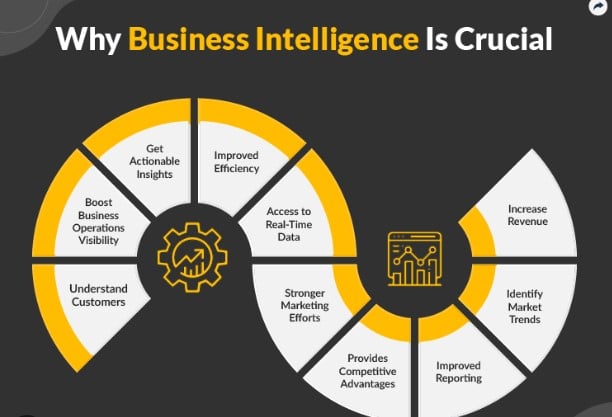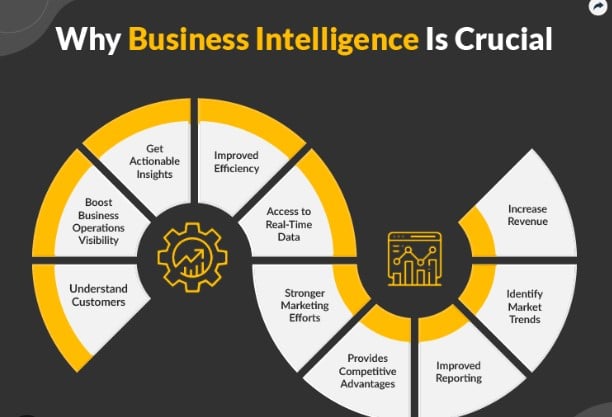The world today is more interconnected than ever, and businesses are no exception. With the advent of technology, businesses are constantly on the lookout for tools to help them analyze, understand, and use their data efficiently. This is where Business Intelligence (BI) comes into the picture.
What Is Business Intelligence (BI)? | Examples & Why to Use BI
Business Intelligence (BI) is a technology-driven process for analyzing data and presenting actionable information to help corporate executives, business managers, and other end users make more informed business decisions. It encompasses a variety of tools, applications, and methodologies that enable organizations to collect data from internal systems and external sources, prepare it for analysis, develop and run queries against the data, and create reports, dashboards and data visualizations to make the analytical results available to corporate decision-makers and operational workers.
A classic example of Business Intelligence in use is the airline industry. Airlines use BI tools to access data on flight schedules, labor costs, fuel prices, and passenger information to make quick and strategic decisions.
The Intricate Fabric of Business Intelligence
Business Intelligence weaves together a rich tapestry of data, using threads of raw information to create patterns that illustrate insightful trends and predictions.
Data Mining in BI: Digging for Gold
Data mining is the process of discovering patterns and relationships in large datasets. It uses a variety of techniques, including machine learning, statistics, and database systems, to extract useful information that can help organizations make informed decisions. Imagine finding nuggets of gold in a sea of unstructured data, that’s the power of data mining!
Online Analytical Processing (OLAP): Turning Data into Insight
OLAP is a complex approach to multidimensional analysis that allows users to analyze data from multiple database systems at one time. Think of it as having a panoramic view of your business data from various angles, providing a holistic view that aids in strategic decision-making.
The Cornerstones of Business Intelligence
Just like a sturdy building, Business Intelligence stands tall on its foundational cornerstones. Each of these components plays a pivotal role in the BI process, empowering businesses to use their data effectively.
Data Warehousing: Storing and Managing Data
A data warehouse is a large storage repository that businesses use to manage, store, and retrieve their data. It’s like a gigantic library of data where the books are well organized and readily available for reference.
Data Visualization: Making Sense of the Numbers
Data visualization is the graphical representation of data and information. It uses visual elements like graphs, charts, and maps to provide an accessible way to see and understand trends, outliers, and patterns in data. In other words, it paints a vivid picture of raw numbers and statistics.
Unlocking the Power of Business Intelligence
In the age of digitalization, businesses that leverage BI tools effectively can unlock a treasure trove of benefits, enabling them to gain a competitive edge.
Informed Decision-Making: Guiding the Business Compass
BI tools facilitate data-driven decision-making, allowing businesses to steer their operations based on factual data instead of gut feelings. It’s like having a compass that guides your business in the right direction.
Increased Efficiency: Streamlining Business Operations
With BI, businesses can identify bottlenecks in their operations and find ways to improve efficiency. It’s like having a personal fitness trainer for your business, helping it stay lean and agile.
The Downside of Ignoring Business Intelligence
While the advantages of embracing Business Intelligence are plentiful, ignoring it could have serious repercussions.
Missed Opportunities: The High Cost of Ignorance
Without BI, businesses might miss out on lucrative opportunities. It’s like walking past a gold mine without realizing its worth.
Inefficient Operations: The Slow March to Decline
Failure to use BI tools can lead to operational inefficiencies and hinder growth. It’s like running a marathon with weights attached to your feet.
Embracing Business Intelligence: The Future of Business
As we navigate through the digital age, embracing Business Intelligence is not a luxury but a necessity. It’s the future of business, and those who adopt it early will lead the way.
Improved Customer Service: Delivering Value
With BI, businesses can understand their customers better and deliver superior service. It’s like having a secret recipe for customer satisfaction.
Enhanced Competitive Advantage: Staying Ahead of the Curve
BI can provide a competitive advantage, allowing businesses to stay one step ahead of their competition. It’s like having a crystal ball that shows the future market trends.
Frequently Asked Questions
1. Is Business Intelligence only for large businesses?
No, Business Intelligence isn’t restricted to large corporations. Small and medium-sized businesses can also leverage BI tools to gain insights and make informed decisions.
2. How does Business Intelligence improve decision-making?
BI tools provide actionable insights by analyzing raw data. This empowers businesses to make strategic decisions based on factual data, rather than relying on intuition.
3. What types of data can Business Intelligence analyze?
BI can analyze a wide range of data, including sales metrics, customer data, operations data, and much more. Essentially, if it’s data, BI can analyze it.
4. Is Business Intelligence difficult to implement?
The implementation of BI can be complex, depending on the size of the organization and the amount of data involved. However, with the right tools and guidance, it can be successfully implemented.
5. What is the role of data visualization in Business Intelligence?
Data visualization is a critical component of BI. It transforms raw data into visual representations, making it easier for decision-makers to understand and interpret complex datasets.
6. Can Business Intelligence predict future trends?
Yes, certain BI tools use predictive analytics to forecast future trends based on historical data.
Conclusion
In the digital age, the question is no longer “What is Business Intelligence?”, but rather “How can we best use Business Intelligence?”. With the power to transform raw data into actionable insights, BI tools are the guiding compass for businesses navigating the sea of digitalization. As we continue to generate and collect data at an exponential rate, the role of BI will only become more prominent, guiding the business decisions of today and the strategic direction of tomorrow.
Read More :
- How B2B Sales Teams Win with Digital Commerce System
- What is a CRM System and How Can it Benefit Your Business?
- Revolutionize Customer Relationships: Exploring the World of CRM Software
- What is CRM? CRM Software Explained (Customer Relationship Management)
- 3 Types of CRM: Analytical, Operational and Collaborative

